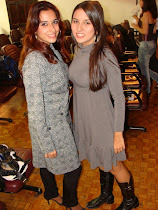29 September 2009
Teaching Methologies - My conceptions
Posted by tabata e bruna. at 8:35 PM 0 comments
Labels: Bruna's portfolio
24 September 2009
Getting to know each other..
Hello people!
Please, if you could, I would appreciate if you answered some of this questions about the course you are taking:
- Are you already teaching? If you are, do you like it?
- What's your favorite subject at the university?
- What do you want to do after finishing your course?
Hope to hear from you soon, thank you, bye bye :]
Posted by tabata e bruna. at 12:44 PM 3 comments
Labels: Tabata's portfolio
22 September 2009
My table about the methodologies..
Posted by tabata e bruna. at 8:06 PM 2 comments
Labels: Tabata's portfolio
My class presentation about..
The Direct method:
- was estabilished in Europe around 1900;
- only the target language is used in class;
- grammar is taught inductively;
- both speech and listening comprehensions are taught;
- was created as an answer to the Grammar Translation Method.
The Audiolingual Method:
- also known as the Army Method;
- it is based on behaviorist theory;
- only the target language is used in class;
- emphasizes listening and speaking;
- use drills and repetitions, no explicit grammar instruction.
Posted by tabata e bruna. at 1:29 PM 0 comments
Labels: Tabata's portfolio
21 September 2009
Immersion programme and natural approach
Immersion programme is a form of bilingual education in which children who speak only one language enter a school where a second language is the medium of instruction for all pupils.
For example, there are schools in Canada for English-speaking children, where French is the language of instruction.
If these children are taught in French for the whole day it is called a total immersion programme, but if they are taught in French for only part of the day it is called a partial immersion programme.
Natural approach can be:
1 - A term form a number of language-teaching methods which were developed in the 19th century as a reaction to the grammar translation method. These methods emphasized:
• The use of the spoken language
• The use of objects and actions in teaching the meanings of words and structures.
• The need to make language teaching follow the natural principles of first language learning.
These methods lead to the direct method.
2 – A term for an approach proposed by Terrell, to develop teaching principles which:
• Emphasize natural communication rather than formal grammar study.
• Are tolerant of learners’ errors.
• Emphasize the informal acquisition of language rule.
Posted by tabata e bruna. at 9:56 PM 0 comments
Labels: Bruna's portfolio
03 September 2009
Classroom Speaking Activities
This is the summary of a text we read in class, we were supposed to do it in groups:
In the text, the author talks about how to deal with activities that involve speaking and working in groups in a classroom. He divides the activities in three different groups.
HARMER, Jeremy. The practice of English language teaching. 3rd edition, Longman
Posted by tabata e bruna. at 12:14 PM 0 comments
Labels: Tabata's portfolio





